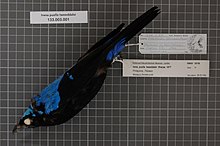| Palawan fairy-bluebird | |
|---|---|

| |
| Male | |

| |
| Female | |
| Conservation status | |
 Near Threatened (IUCN 3.1) | |
| Scientific classification | |
| Domain: | Eukaryota |
| Kingdom: | Animalia |
| Phylum: | Chordata |
| Class: | Aves |
| Order: | Passeriformes |
| Family: | Irenidae |
| Genus: | Irena |
| Species: | I. tweeddalii |
| Binomial name | |
| Irena tweeddalii Sharpe, 1877 | |
The Palawan fairy-bluebird (Irena tweeddalii) is a species of bird in the family Irenidae. It is endemic to the island of Palawan in the Philippines. Its natural habitats are tropical moist lowland forest and it is declining due to habitat destruction and deforestation.
Description and taxonomy
EBird describes the bird as "Spectacular forest-dweller with blood-red eyes, endemic to Palawan and surrounding smaller islands. Gathers at fruiting and flowering trees. Frequently gives rising “wit!” notes, often in bursts of three, as well as incorporating them into short, melodious song."
Exhibits sexual dimorphism in which male are midnight black and electric blue while the female is dark turquoise with dark wingtips.
It was formerly conspecific with the Asian fairy-bluebird but split due to plummage differences with males have a lighter more electric blue versus the darker blue of the former. Females are duller and more turquiose in color.
It has been observed feeding on invertebrates but otherwise diet is largely unknown. It is often seen foraging alone or in pairs foraging in the understorey.
Ecology and behavior
This specific species diet and breeding ecology has yet to be comprehensively studied but its diet is pressumed to be very similar to the Asian fairy-bluebird which mainly feeds on berries, figs and nectar. It also supplements its diet with some insects. Forms small flocks and also joins mixed species flocks of insectivores to forage. The Asian fairy-bluebird nests 2 to 6 meters high in palms. The nest is small and shallow cup made of flimsily arranged twigs and is typically built by the female. Clutch size of 2, occasionally 3, eggs.
Habitat and conservation status

The species inhabits tropical moist lowland primary forest and secondary forest up to 1,000 meters above sea level.
It is assesed as near threatened under the IUCN with populations believed to be decreasing due to habitat loss, deforestation, hunting and the cage bird trade. The whole of Palawan was designated as a Biosphere Reserve; however, protection and enforcement of laws has been difficult and these threats still continue. It occurs in the protected area in Puerto Princesa Subterranean River National Park.
References
- BirdLife International (2018). "Irena tweeddalii". IUCN Red List of Threatened Species. 2018. Retrieved 26 July 2021.
- "Palawan Fairy-bluebird - eBird". ebird.org. Retrieved 2024-08-22.
- Wells, David; Elliott, Andrew; Kirwan, Guy M.; Rasmussen, Pamela C.; Boesman, Peter F. D. (2023). "Asian Fairy-bluebird (Irena puella), version 1.2". Birds of the World. doi:10.2173/bow.asfblu1.01.2. ISSN 2771-3105.
- Allen, Desmond (2020). Birds of the Philippines. Barcelona: Lynx and Birdlife International Guides.
- IUCN (2018-08-09). Irena tweeddalii: BirdLife International: The IUCN Red List of Threatened Species 2018: e.T103775167A132193456 (Report). International Union for Conservation of Nature. doi:10.2305/iucn.uk.2018-2.rlts.t103775167a132193456.en.
| Taxon identifiers | |
|---|---|
| Irena tweeddalii | |
This songbird-related article is a stub. You can help Misplaced Pages by expanding it. |